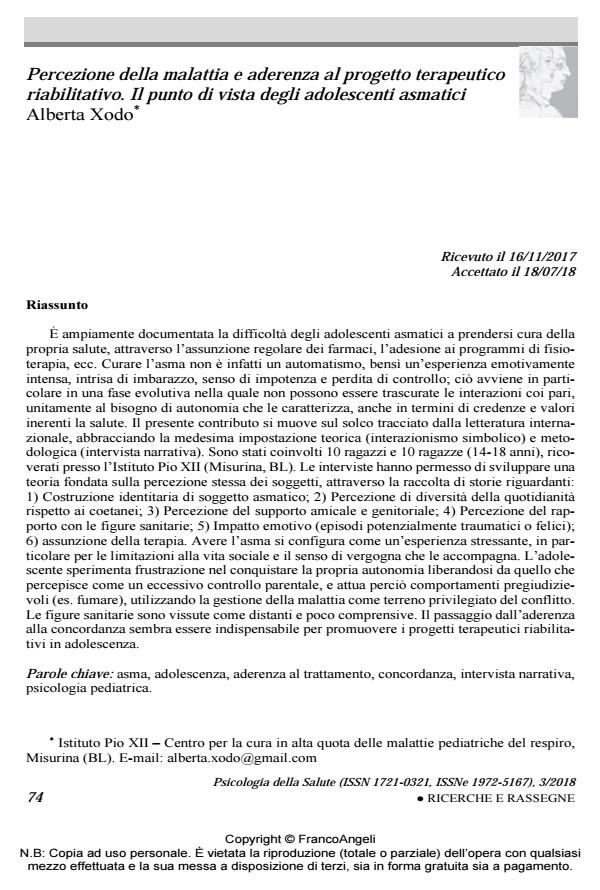Disease perception and adherence to the therapeutic rehabilitation project. Asthmatic ado-lescents’ point of view
Journal title PSICOLOGIA DELLA SALUTE
Author/s Alberta Xodo
Publishing Year 2018 Issue 2018/3
Language Italian Pages 21 P. 74-94 File size 234 KB
DOI 10.3280/PDS2018-003004
DOI is like a bar code for intellectual property: to have more infomation
click here
Below, you can see the article first page
If you want to buy this article in PDF format, you can do it, following the instructions to buy download credits

FrancoAngeli is member of Publishers International Linking Association, Inc (PILA), a not-for-profit association which run the CrossRef service enabling links to and from online scholarly content.
The difficulty of asthmatic adolescents to take care of their own health through a regular intake of drugs and the adhesion to the physiotherapic treatments, it is very well documented. Curing asthma is not automatic, since it is an emotionally intense experience, where em-barrasment, sense of powerfulness and loss of control are perceived. All the above cannot be neglected particularly in an evolutive stage which is characterized by the relationships between peers together with a need for authonomy even on beliefs and values about health. This article follows the line marked by international literature, using the same theoretical and methodological setting (symbolic interactionism and narrative interview). 10 boys and 10 girls between 14 and 18 years old, admitted to Istituto Pio XII (Misurina, BL) were enrolled in the study. The interviews allowed the researchers to develop a theory based on the subjects’ self perceptions. The stories collected were about: 1) Identity building of an asthmatic person; 2) perception of the different daily lifestyle compared to persons of the same age; 3) Perception of friends and parents support; 4) Perception of the relationship with health professional; 5) Emotional impact (both happy and potentially traumatic experiences); 6) Therapy adherence. Having asthma is a stressful experience, particularly about the limitations on social life and the shame connected with it. Adolescents experience frustrations when they try to conquer their own authonomy by getting rid of what they perceive as an excessive parental control, so they carry out prejudicial behaviours (e.g. smoking) using their illness management as a favored battlefield. Health professionals are experienced as aloof and unsympathetic. The passage from therapeutic adherence to therapeutic agreement seems to be essential to promote rehabilitation projects in adolescents.
Keywords: Asthma, adolescent, treatment adherence, agreement, narrative interview, pediatric psychology.
- Il processo di aderenza alle disposizioni precauzionali COVID-19 in 55 bambini trevigiani intervistati nei primi 10 giorni di quarantena successivi al DPCM 9 marzo 2020 Alberta Xodo, Monica Conz, Sara Vianello, Luana Buffon, in PSICOLOGIA DELLA SALUTE 1/2022 pp.91
DOI: 10.3280/PDS2022-001006
Alberta Xodo, Percezione della malattia e aderenza al progetto terapeutico riabilitativo. Il punto di vista degli adolescenti asmatici in "PSICOLOGIA DELLA SALUTE" 3/2018, pp 74-94, DOI: 10.3280/PDS2018-003004